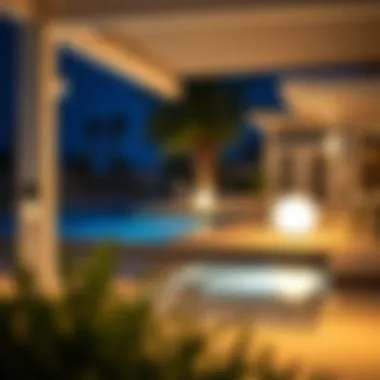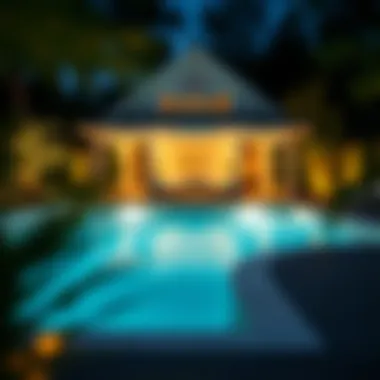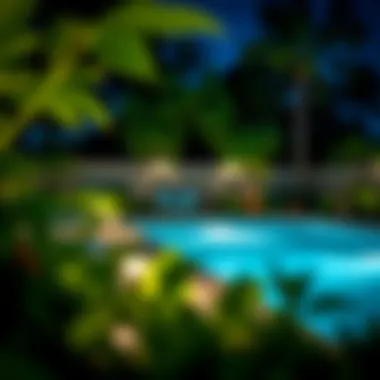Low Voltage Pool Deck Lighting: A Comprehensive Guide


Intro
Creating a visually appealing and functional outdoor space can significantly enhance the overall experience of your home, especially around water features like pools. One noteworthy element that has gained traction in recent years is low voltage lighting for pool decks. Not only does it make the area safer during twilight and night hours, but it also carves out a charming atmosphere where friends and family can gather. This guide aims to illuminate the essentials of low voltage pool deck lighting, including various styles, energy efficiency considerations, and maintenance tips, all tailored for homeowners and design enthusiasts.
Through this exploration, we will touch on how to meld safety with style, ensuring that your poolside area is both inviting and practical. From trendy fixture types to the science behind energy savings, there’s much to delve into as we turn the spotlight on low voltage solutions.
Design Inspirations
As the sun dips below the horizon, thoughtfully designed lighting can transform your pool deck into a show-stopping oasis. Below, we’ll tackle the trends and color choices that can guide your design decisions for creating a stunning outdoor environment.
Trending Styles
When it comes to low voltage lighting, various styles can cater to diverse tastes and architectural themes. Here are a few popular ones:
- Modern Minimalism: Clean lines and geometric shapes define this approach. Fixtures are often sleek and unobtrusive, allowing the natural beauty of your pool to shine through.
- Rustic Charm: This style employs warm-hued lights and fixtures made of materials like wrought iron or wood, adding an earthy touch to the overall design.
- Coastal Vibes: With interspersed lighting along pathways and decks, this style evokes the tranquility of beach life. Fixtures may be inspired by lanterns or seashells, enhancing the marine theme.
Color Palettes
Selecting the right color temperature can make a world of difference. Here are some recommendations:
- Warm White (2700-3000K): Ideal for creating cozy environments, perfect for evenings by the pool.
- Cool White (4000K): Offers a more modern feel and boosts visibility, making it an excellent choice for safety.
- RGB Fixtures: Using color-changing LED fixtures can bring an exciting energy to evening gatherings, allowing you to match the vibe to the occasion.
Ultimately, the aim is to strike a balance between safety and aesthetics, aligning your choices with your lifestyle and preferences.
Maintenance and Upkeep
Low voltage lighting is not devoid of upkeep, which is necessary to ensure longevity and efficiency. Regular maintenance checks can help dodge inconvenient surprises and keep your outdoor space looking its best.
Seasonal Maintenance Checklist
- Inspect Wiring: Check for any frays or exposure that may lead to malfunctions.
- Clean Fixtures: Dust and debris can accumulate, impacting brightness. Regular cleaning with a gentle cloth can work wonders.
- Test Light Function: Confirm that all lights are functioning to detect any burnt-out bulbs early.
Cleaning and Organization Tips
- Use Soft Brushes: A soft-bristle brush can be handy for fixture cleaning without scratching their surfaces.
- Store Fixtures Safely: During the off-season, consider removing more delicate fixtures and storing them in a dry, safe environment to prolong their lifespan.
By adhering to these maintenance standards, you ensure both the aesthetic appeal and functionality of your outdoor lighting system.
"Outdoor lighting is not just about brightness; it creates a canvas for your space, combining beauty with practicality."
With deliberate design choices and regular upkeep, low voltage pool deck lighting can redefine your outdoor experience, inviting you to enjoy your space long after the sun goes down.
For more insights on outdoor lighting, consider visiting resources like Wikipedia or Britannica.
Foreword to Low Voltage Pool Deck Lighting
Lighting can make or break the overall atmosphere of outdoor spaces, especially around a pool deck where comfort and safety converge. Low voltage pool deck lighting plays a pivotal role not just in beautifying this vital area but also in enhancing functionality during nighttime use. Using electrical systems that operate at a lower voltage, typically 12 volts, not only meets safety standards but also reduces operating costs and energy consumption compared to traditional high-voltage systems.
The beauty of low voltage lighting lies in its versatility and ease of installation. Homeowners who may feel daunted by high-voltage wiring can easily install low voltage fixtures, making it a DIY project for those looking to elevate their outdoor space without a hefty contractor bill. The variety of fixtures available is remarkable, ranging from subtle path lights that guide footsteps to bold spotlights that highlight architectural features or plant beds.
Several benefits accompany these systems:
- Safety: Low voltage lighting minimizes the risk of electric shock, making it a safer choice for poolside areas where moisture is present.
- Energy Efficiency: With low energy consumption, these fixtures can illuminate your pool area without a shocking electricity bill at the end of the month.
- Aesthetic Appeal: Using thoughtfully placed fixtures, you can create inviting spaces that draw people into your outdoor havens, setting the stage for evening gatherings or tranquil stargazing.
It’s crucial to take several considerations into account when choosing low voltage lighting. For instance, you must evaluate the specific needs of your space, such as brightness and the type of fixtures that blend well with the existing elements. Careful planning goes a long way in ensuring that the lighting not only fits practical needs but also contributes to a cohesive aesthetic.
In essence, low voltage pool deck lighting is about more than illumination; it’s about weaving safety, ambiance, and efficiency into the nighttime tapestry of your outdoor space. Becoming familiar with the fundamental aspects and benefits enhances the design process, allowing you to craft an inviting area that's both functional and visually appealing.
"Good lighting is not just about seeing; it’s about feeling."
Armed with this knowledge, you’re already a step ahead in transforming your outdoor paradise into a delightful retreat, whether for fun gatherings or quiet evenings spent by the water.
Understanding Low Voltage Lighting Systems
Low voltage lighting systems have blossomed into a must-have element for any outdoor space, especially when it comes to pools and recreational areas. Their increasing popularity isn’t just a fad; it stems from their energy efficiency, safety, and flexibility in design. Understanding these systems is paramount for homeowners looking to enhance their outdoor ambiance without breaking the bank or sacrificing safety.
Definition and Mechanism
Delving into what low voltage lighting actually means, it operates within a voltage range that is significantly lower than standard household systems, typically around 12-24 volts. This fundamental distinction allows for a safer environment around pools where water and electricity pose a dire risk.
Low voltage lighting systems utilize a transformer to reduce the standard line voltage down to a lower voltage. This transformer plays a vital role. It changes the higher voltage to a manageable level, negating many of the dangers associated with electrical systems. The wiring used is also less thick, making installation easier and less invasive. Commonly, these systems incorporate LED technology which pairs well with low voltage due to its efficiency and longevity.
Advantages Over Standard Voltage Systems
When we weigh the benefits of low voltage systems against high voltage options, the scales obviously tip in favor of the former. Key advantages include:
- Safety: The primary selling point for many. Low voltage minimizes electrical hazards, particularly critical where water is involved. Homeowners can feel more secure allowing children and pets to roam freely without the looming fear of shock.
- Flexibility in Design: With lower installation requirements and less invasive wiring, low voltage systems grant designers and homeowners the freedom to implement numerous lighting fixtures. You can adorn pathways, accentuate features, or achieve subtle glow all around the deck without extensive work.
- Energy Efficiency: These systems consume less power, which not only boosts sustainability credentials but also results in lower electricity bills – a win-win for both the planet and your wallet.
- Longevity and Durability: With the incorporation of LEDs that can last significantly longer than traditional bulbs, maintenance becomes less of a chore. The need for constant bulb replacements falls by the wayside, allowing homeowners to enjoy their beautifully lit outdoor spaces for years, if not decades.
Together, these components illustrate why grasping the mechanics and advantages of low voltage lighting systems is pivotal for anyone looking to enhance their outdoor experience. Not only does it ensure safety and visual appeal, but it also aligns well with modern eco-conscious values.
"Low voltage lighting systems present an essential blend of safety, efficiency, and design flexibility that elevates any outdoor space."


In the broader discussion on outdoor décor, these systems offer a foundation that homeowners should consider vital, seamlessly merging style with function.
Designing Your Pool Deck Lighting
Designing the lighting for your pool deck isn’t just about illumination; it's creating an atmosphere that invites relaxation, enhances safety, and gives your outdoors a polished aesthetic. Good lighting design can transform the mundane into the magical, offering both functionality and visual appeal. Whether you’re hosting a summer soiree or enjoying a serene night swim, well-thought-out lighting creates the perfect backdrop.
The style and layout of your lighting should echo your personal taste while complementing the architectural features of your home and outdoor setup. Homeowners often underestimate how the right fixtures can pull together an entire ambiance. Instead of focusing on just brightness, think about how shadows and soft glows can enhance corner areas around your pool.
Creating a Cohesive Aesthetic
When contemplating the design of your pool deck lighting, consider what you want to emphasize. Consistency is key. Choosing fixtures that reflect the materials or colors of your decking and surrounding environment aids in creating an overall cohesion. For instance, if you have a wooden deck, using fixtures made from natural materials or those that imitate wood can tie everything together seamlessly.
To ensure uniformity, aim for:
- Similar Styles: If your outdoor furniture is sleek and modern, choose similarly styled fixtures.
- Consistent Color Temperature: Opt for warm white lights for a cozy feel or cooler temperatures for a sleek appearance.
Opting for fixtures that match or complement existing landscape elements, like stone walls or garden features, develops a layered effect, drawing the eye throughout the space. The end goal here is to create an inviting look, enticing friends and family to linger by the pool long into the evening.
Focal Points and Directional Lighting
Using light to dictate where attention goes is a savvy approach in enhancing the aesthetics of your pool area. Focal points, such as a water feature or striking landscaping, should be highlighted through pointed fixtures, such as spotlights. This helps frame the key aspects of your yard, steering the eye to where you want it to go, while also offering practical illumination for safety.
Consider using:
- Path lights to guide guests safely from one area to another.
- Wall-mounted fixtures to illuminate vertical features like columns or trees, adding dimension and character.
The thoughtful placement of lights can make a significant impression. For example, uplighting trees can create enchanting shadows, promoting a forest-like feel around your pool. Conversely, downlighting from overhead structures can simulate the soft glow of moonlight, creating a serene environment.
Layering Light for Depth and Ambiance
Layering different types of lighting is crucial to create depth and charm in your outdoor space. Rather than flooding the area with a single harsh source of light, mixing ambient, task, and accent lighting can yield a more inviting atmosphere.
- Ambient Lighting: This forms the base illumination. Typically accomplished through overhead fixtures or recesses in the deck.
- Task Lighting: Essential for functional areas like cooking, cleaning, or safety purposes around stairs or entry points.
- Accent Lighting: Draws attention to specific features in your decor – think about those underwater lights ideal for showcasing the beauty of your pool at night.
Remember, the intensity and angle of light can alter perception and mood. By creating zones with softer light settings for lounging and brighter spots around the barbecue area, you establish a dynamic flow throughout the space. Incorporating this layered approach not only enhances the utility of your pool deck but beckons a captivating ambiance, where conversations can flow and memories can be made.
"The right design doesn’t just highlight; it narrates. Let your lighting tell the story of your outdoor space.”
In closing, when designing your lighting, remember it’s about employing a combination of styles and strategies to create something unique to you and your space. This harmonious approach will lead to a pool deck that’s as fashionable as it is functional.
Types of Fixtures for Pool Deck Lighting
When it comes to transforming your pool deck into a stunning nighttime retreat, the types of fixtures you choose can make all the difference. Each lighting fixture brings its own unique characteristics and benefits, influencing the functionality and aesthetics of the area.
Path Lights
Path lights serve a fundamental purpose in pool deck lighting. Not only do they illuminate walkways and areas surrounding the pool, but they also set a welcoming tone for guests. When strategically placed, these fixtures can guide people safely to and from the deck, ensuring nobody trips over any hazards. They often come in a variety of designs, from sleek modern styles to more traditional forms. This versatility allows homeowners to choose options that complement their existing decor.
Moreover, path lights can enhance the natural elements around the pool, such as gardens and landscaping, creating a beautifully integrated space. Using LED bulbs in path lights ensures energy efficiency without sacrificing brightness. These fixtures can be installed with low voltage systems, making them both safe and economical.
Spotlights and Floodlights
Spotlights and floodlights take pool deck lighting to another level. They serve as powerful tools to highlight specific features, such as water fountains or architectural details of the home. Spotlights focus on a narrow beam of light, making them suitable for accentuating particular areas. Floodlights, on the other hand, cast a broader beam, perfect for brightening larger spaces.
Choosing the right angle and position can profoundly change how these lights affect the ambiance. It’s crucial to avoid harsh shadows that could deter from the serene atmosphere. When installed above or on nearby trees, these lights can create enchanting effects, transforming the surroundings after dark.
Underwater Lighting Solutions
Underwater lighting is essential for a complete pool experience. Not only do these lights enhance security for swimmers, but they also elevate the visual appeal of the pool. Options like LED fixtures can usually shift colors, offering a spectacular light show that can match the mood of any occasion—from a vibrant party to a relaxing evening.
These lights can create a dramatic effect when illuminating the water, highlighting the clear surface and giving it an inviting glow. Moreover, they come with services that ensure they are designed to withstand water pressure and potential wear and tear from pool chemicals.
Deck and Step Lighting
Deck and step lighting is vital for safety and style. These fixtures are uniquely designed to be low-profile yet effective. They can either be embedded into the decking or mounted on the sides of steps, providing essential visibility in the dark. This is particularly important for pools, where slippery surfaces can be a risk during evening swims.
Incorporating LED lights in these fixtures ensures minimal energy consumption while providing bright illumination. Additionally, choosing lights that can be dimmed adds to the versatility for guests who may prefer softer lighting while lounging poolside.
In summary, selecting the right type of lighting fixture is crucial in creating a safe and inviting atmosphere around your pool. Each type offers distinct advantages, enhancing not just safety but also the overall aesthetic of your outdoor space. Remember, a well-lit pool deck can be transforming—not just for gatherings but for your personal enjoyment as well.
"A well-lit pool deck is an invitation to linger. It transforms ordinary moments into unforgettable memories."
For further insights on lighting strategies, check out Wikipedia on Outdoor Lighting or Britannica's guide for historical and technical information.
Installation Process for Low Voltage Pool Deck Lighting
When it comes to illuminating your pool deck, the installation process for low voltage lighting is a game changer. This phase not only defines how well your lights function but also influences the safety and aesthetics of your outdoor space. With a range of components and layouts to consider, getting the installation right can improve ambiance while minimizing energy consumption. Additionally, understanding the installation intricacies can empower homeowners to take on this DIY project and enhance the overall enjoyment of their pool area.
Planning Your Lighting Layout
First off, planning is key. You can't just throw lights around willy-nilly and hope for the best. Take the time to sketch out your area and identify where you want the light to hit. Consider any obstacles like trees or furniture that can block light. Here, establishing focal points—such as the pool itself, seating areas, or other features—can create a visually pleasing design. Think about how to mix light and shadow effectively. The aim is to draw the eye without causing distractions.


Tips for Layout Planning:
- Decide on the mood you want to create.
- Use a light meter for broader areas if needed.
- Walk the space at night with a flashlight for perspective.
Tools and Materials Required
Getting the right tools and materials is half the battle. Without the essential assortment, the process can quickly become a headache. For low voltage lighting installations, gather a few very affordable yet important tools: a shovel, wire connectors, a voltage tester, and possibly a drill.
Key materials include:
- Low voltage lighting fixtures of your choice.
- Outdoor-rated wire, typically 12- or 14-gauge.
- Transformers compatible with low voltage systems.
- Connectors and waterproof strain reliefs to prevent corrosion.
Make sure your supplies match the size of your project. Knowing the recommended materials helps assure a smooth install, avoiding delays mid-project.
Step-by-Step Installation Guide
Preparing the Site
Before getting your hands dirty, preparing the site is vital for an effective installation. This involves clearing any debris, moving furniture, and maybe even leveling the ground in spots where you wish to place fixtures. A well-prepared site promotes better results by ensuring that cables conduct power efficiently without unexpected interruptions due to imperfections in the ground or other hitches.
This step is crucial because a clean backdrop allows for a more efficient wiring process and a neat finish, which is not just visually appealing but also helps in maintaining the longevity of your setup.
Laying the Wiring
Once you’ve got a clean slate, it’s time to lay the wiring. Proper laying of the wire is instrumental for optimal performance of your lighting setup. Dig shallow trenches that are around 6 to 12 inches deep to house the wire. This helps protect against physical damage and weather hazards. Using proper gauge wire is essential here, as using too thin a wire can lead to voltage drop issues, impacting light quality and longevity.
When laying out the wires, it’s also a good idea to keep them away from the pool or any water sources to avoid potential hazards. You might spend a bit more time on this phase, but it’s worth it for the sake of stability and safety.
Mounting Fixtures
After you’ve laid the wiring correctly, mounting the fixtures comes next. This step entails securely fixing the light fixtures in their designated positions. Depending on the fixture type, you may need to use various fasteners, like screws or brackets. The key feature here is ensuring the fixtures are at the correct height and angle to maximize light coverage with minimal shadowing. Each fixture should be checked for levelness before securing.
Connecting to Power Source
Finally, the last step—connecting your system to a power source—cannot be overlooked. Carefully follow the instructions provided with your transformer and fixtures. Ensure connections are tight, and use the proper connectors to prevent any loose ends that might lead to failure. Once connected, it's wise to perform a voltage test to ensure everything is functioning as it should.
In this phase, bear in mind that taking shortcuts can lead to issues down the line, so prioritizing a solid connection gives you peace of mind.
"Safe and secure wiring is fundamental to enjoying your low voltage lights for years to come."
Taking these installation steps seriously will set the stage for a beautifully illuminated pool deck that invites leisurely evenings and showcases your outdoor space in the best light.
Energy Efficiency Considerations
When it comes to illuminating outdoor spaces like pool decks, energy efficiency is more than just a buzzword; it's pivotal for both environmental concerns and homeowner expenses alike. With the proper strategies and fixtures, you can create a beautiful ambiance while keeping those pesky utility bills in check. Let’s explore the essential aspects of energy efficiency in low voltage pool deck lighting and why you should take them into account.
Choosing Energy-Efficient Fixtures
Choosing the right fixtures is the first step in creating an efficient lighting system. Not all bulbs are created equal; some use a lot more energy than others. When selecting fixtures, opt for LED lights over traditional incandescent choices. LEDs not only last longer but also use a fraction of the energy, often as low as 20-25% compared to their incandescent cousins.
Here are a few features to look for in energy-efficient fixtures:
- Lumens per watt: Higher lumens per watt means better efficiency.
- Dimmability: Fixtures that can dim allow greater control, consuming less power when full brightness isn’t needed.
- Color temperature: Look for warm white LEDs, usually around 2700-3000K, which emulate a natural feel.
Utilizing Timers and Sensors
Another fantastic way to amp up energy efficiency is by incorporating timers and sensors into your lighting system. Timers allow you to set specific on and off times for your lights, ensuring they’re not draining energy when not in use. For instance, you can schedule them to turn on just before sunset and turn off after midnight.
Similarly, motion sensors can be a real game-changer! They’ll help to light up pathways and areas only when someone is present, reducing unnecessary energy use. In fact, many homeowners have reported significant savings after installing these systems. Imagine walking outside and having your pool area instantly light up as you approach, all the while being kinder to the planet and your wallet!
Solar Powered Options
Don’t forget about solar-powered lighting as an alternative! They are very efficient and can save you a boatload on your electricity bills. Solar lights use energy from the sun, meaning no extra wiring and no extra costs for electricity.
Though it’s pivotal to think about placement, as the efficiency of these lights depends on exposure to sunlight. A good rule of thumb is to position them in areas where they can get at least six hours of sunlight a day. Moreover, modern solar options come with advanced features, like integrated LED technology and even smart sensors, enhancing both functionality and aesthetic appeal.
"Energy efficient lighting benefits both your pocket and the environment, making it a win-win for homeowners."
In summary, approaching the energy efficiency of your low voltage pool deck lighting with the right fixtures, timers, sensors, and perhaps even solar options, greatly enhances your ability to create a stunning and sustainable outdoor space. Not only does this align with eco-friendly practices, but it also allows your investment to pay off through lower energy costs over time. A little thought into these areas ensures your outdoor lighting harmonizes with environmental and economic sensibilities.
Maintenance of Low Voltage Lighting Systems
Maintaining low voltage lighting systems is not just about enhancing aesthetics; it’s about safety, efficiency, and longevity. Neglecting this crucial aspect can lead to dim and uninspiring outdoor spaces, not to mention potential hazards. So, ensuring that these systems are well-maintained can save you both time and money in the long run. Regular upkeep helps sustain the glowing ambiance you desire while promoting safety for those enjoying your pool area.
Routine Checks and Cleaning
Routine checks are the bedrock of maintenance for low voltage lighting. Think of them as the backbone of your lighting system, keeping everything running smoothly. Start by inspecting the fixtures regularly—at least once every couple of months is a good ballpark.
- Check for debris: Leaves, dirt, and other debris can block light output. Clean fixtures with a damp cloth, and if needed, a mild soap solution.
- Examine for rust or corrosion: Look out for any signs of wear and tear, particularly at the connections where moisture can sneak in and create problems.
- Monitor light output: If a fixture seems dimmer than usual, it might be time for a more thorough inspection.
Keeping an eye on these elements not only enhances the aesthetics but also helps in preventing costly repairs down the line.


Identifying and Replacing Bulbs
Identifying and replacing bulbs in your low voltage lighting setup is a task that can often be overlooked until it’s too late. Don’t wait until a gloomy evening surprises you with dead lights! Here’s how to tackle it effectively:
- Know your bulbs: Familiarize yourself with the specific type of bulbs used in your fixtures. LED, halogen, or CFL all have different lifespans and replacement procedures.
- Test the fixture: If a bulb isn’t lighting, it may not be burnt out. Check the connections first. If connections are secure and there's still no light, replace the bulb. Make sure to use bulbs compatible with your lighting system.
- Keep spares: Having a few replacement bulbs on hand can make a world of difference. That way, you can quickly swap them out and keep your atmosphere bright for any gathering.
The task of changing bulbs can be straightforward, but ignoring it can lead to uneven lighting, losing that inviting glow.
Ensuring Proper Wiring and Connections
Proper wiring and connections are critical to the safe operation of your low voltage lighting system. Faulty wiring can lead to more than just a dark pool deck; it can potentially create serious safety hazards.
- Inspection of wiring: Check for signs of wear or fraying. Look at the connections to ensure they’re not loose. Even a tiny gap can lead to inconsistent lighting.
- Grounding: Make sure that fixtures are properly grounded. This is crucial to prevent electrical shocks and to keep your lighting system running efficiently.
- Avoid overloading circuits: If you find yourself heavily relying on one circuit, it might be worth discussing options with an electrician. Overloading can lead to failures and, even worse, safety risks.
Prioritizing these checks helps ensure that not only do you have a brightly lit space but also that everyone can enjoy it safely.
"A stitch in time saves nine."
Taking care of your low voltage lighting system through routine maintenance, timely bulb replacement, and secure wiring ensures a consistent and inviting experience for family and guests alike.
Safety Considerations in Pool Deck Lighting
When it comes to designing your low voltage pool deck lighting, safety is not just a minor detail—it's the backbone of every successful project. Ensuring a secure environment becomes paramount, especially given the unique hazards associated with water and electricity. With thoughtful planning and attention to detail, you can strike a perfect balance between beauty and safety, allowing you to enjoy your outdoor oasis without a worry in the world.
Avoiding Electrical Hazards
The interaction of water and electricity poses the greatest risk in areas surrounding swimming pools. Low voltage systems significantly reduce these hazards, but they are not entirely devoid of risk. Here are some considerations:
- Use Yard-Grade Power Cables: Opt for cables designed specifically for outdoor use. These often feature protective coatings that resist moisture, UV rays, and temperature extremes.
- Proper Fixture Ratings: When selecting fixtures, make sure they are rated for wet or damp locations. Not all lights can stand up to moisture exposure, but water-resistant designs will help you avoid accidents.
- Keep Connections Dry: Whenever possible, avoid leaving exposed wiring. Weatherproof connectors and junction boxes are your best friends in keeping those connections safe and dry.
"Electrocution can happen without a single wet foot in sight. Protect yourself, and those you care about, by being proactive with safety measures."
Weather Resistance and Durability
Your pool deck's lighting faces significant challenges from the elements. Harsh winters, heavy rains, and blazing summers all take their toll. Hence, selecting fixtures that endure this wear and tear is crucial. Here are points to ponder:
- Corrosion-Resistant Materials: Stainless steel, brass, or high-grade plastics are great materials that withstand exposure without failing. They promise long life, keeping your lighting functioning properly for years to come.
- Sealing: Ensure that fixtures come with proper seals to protect the internal components from moisture. Sealed designs keep the light bright and the circuits intact.
- Protection Ratings: Familiarize yourself with Ingress Protection (IP) ratings, which indicate how resistant a fixture is to dust and water. An IP65 rating or above is often considered suitable for poolside areas.
Grounding and Circuit Protection
Grounding your lighting system is an often-overlooked yet crucial component that ensures electrical safety. Here's a breakdown of the essentials:
- Grounding Wires: Always incorporate a grounding wire in your installations. This directs excess electricity safely into the ground, reducing the risk of shock.
- Circuit Breakers: Use circuit breakers to provide an additional layer of protection. These devices automatically shut off the electricity in case of a fault, mitigating potential hazards effectively.
- GFCI Outlets: Ground Fault Circuit Interrupter (GFCI) outlets should be utilized for any outdoor power source. These outlets monitor electricity flow and cut off power if they detect leakage, thus minimizing the risk of electrical shocks.
Keeping safety at the forefront while designing your pool deck lighting is essential. By following these guidelines related to electrical hazards, weather resistance, and appropriate grounding and protection methods, one can create a stunning yet secure outdoor environment.
Innovative Trends in Pool Deck Lighting
The realm of pool deck lighting has experienced a seismic shift over recent years with a focus on innovation and efficiency. Embracing innovative trends not only transforms the aesthetic appeal of outdoor spaces but also introduces a sense of functionality and modernity that caters to today's discerning homeowners. The adoption of these trends can drastically enhance an environment, creating an inviting atmosphere that extends usability well into the night. Understanding these advancements is crucial for anyone looking to optimize their poolside experience, as they offer both convenience and cutting-edge aesthetics.
Smart Lighting Technology
Smart lighting technology has revolutionized the way we approach outdoor lighting design. With the integration of smart features, homeowners can control their lighting systems remotely via smartphone applications. This level of control provides unmatched versatility, allowing for adjustments in brightness, color, and even scheduling options to align with personal lifestyles. Features like programmable timers and motion sensors not only enhance the ambiance but also improve energy efficiency by ensuring lights are only on when needed.
One appealing aspect of smart technology is its compatibility with home automation systems, making it easier to create a cohesive aesthetic across various outdoor spaces. Imagine being able to change the hue of your pool deck lights with a tap of your finger while sipping a cocktail at your patio. This creates not only a practical solution for managing lighting but also opens up new avenues for creating themed gatherings.
Color Changing LED Options
Color changing LED lights are another trailblazing feature in pool deck lighting. They offer a level of customization that traditional lighting simply cannot match. By providing an array of colors, these fixtures allow homeowners to set the mood for any occasion—from serene blue hues for tranquil evenings to vibrant greens and reds for lively parties. The shift from standard warm white lighting to dynamic colors offers an exciting way to enhance your outdoor atmosphere.
Additionally, color changing technology is highly energy-efficient. These LEDs consume less power than conventional bulbs and have a longer lifespan, translating to cost savings over time. The ability to change colors based on season or event can transform a pool area, making it feel fresh and engaging, as if the space is always evolving.
Integration with Outdoor Living Spaces
The seamless integration of pool deck lighting with outdoor living spaces is an important consideration when designing any ambiance. Rather than viewing lighting as an afterthought, modern architects and designers think of it as part of the overall layout. This trend emphasizes creating a unified look that ties together elements such as patios, gardens, and lounge areas with the pool.
Effective use of lighting enhances not only the appearance but also the functionality of these spaces. Fixtures that blend harmoniously with furniture and landscaping contribute to an inviting atmosphere where outdoor enjoyment thrives.
Incorporating a variety of lighting types—path lights, spotlights, and even under-bench lighting—can establish a cohesive theme across your entire backyard.
Emphasizing connection and unity, this trend shows that well-placed lights can guide visitors through a space, enhancing visibility while adding to the aesthetic appeal.
Finale: Enhancing Your Outdoor Space
When considering how to transform your outdoor area, low voltage pool deck lighting emerges as an essential tool for improvement. This approach does not just provide illumination; it creates an atmosphere that can elevate the overall experience of your poolside. Realistically, the way you light your space can make all the difference between a mere functional area and a stunning retreat.
Aesthetic Benefits
Designing with low voltage lighting in mind offers countless opportunities to blend functionality with beauty. You can highlight landscape features, emphasize pool contours, and illuminate pathways, guiding guests seamlessly throughout your outdoor area. The way a light softly reflects off water can change the entire mood of an evening gathering, casting a soft glow that encourages relaxation instead of stark brightness.
Safety and Practical Considerations
In addition to aesthetic enhancements, safety cannot be overlooked. Strategically placed lights improve visibility around the pool, reducing the risk of accidents after sundown. It is also vital to ensure that all lighting installations are compliant with local regulations, fostering a safe environment for family and guests alike.
Energy Efficiency
Embracing low voltage systems also aligns with an eco-friendly mindset. Not only do these systems consume less energy compared to traditional options, but they can also be paired with timers and sensors for even greater efficiency. Homeowners can end up saving money in the long run while contributing positively to the environment. Think of it as a win-win situation—your wallet stays fuller while you do your part for the planet.
Innovative Possibilities
As technology advances, so do the possibilities within outdoor lighting. The integration of smart lighting allows for unparalleled control over your pool deck ambiance. Homeowners can tweak light colors or brightness with a swipe on a smartphone, adjusting their outdoor vibe to suit any occasion. The days of static lighting are long gone, making way for dynamic, customizable outdoor spaces.
"Lighting is the brush, and the outdoor space is your canvas"







